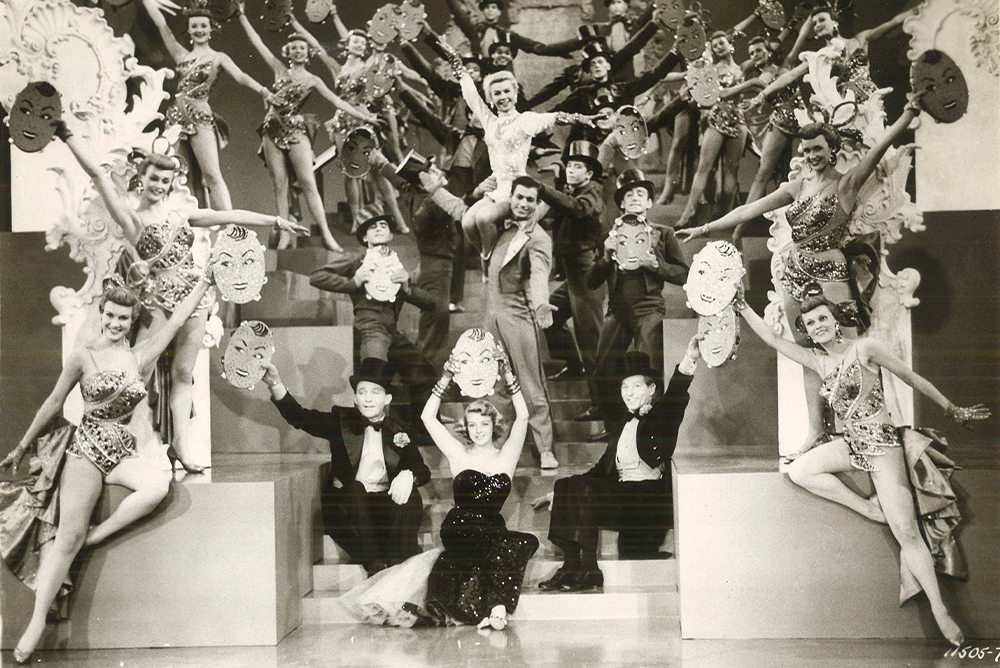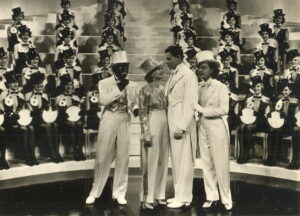
Bing Crosby, Rosemary Clooney, and ensemble perform “Mandy” in White Christmas, 1954. The song always maintained a connection to the minstrel stage, Brynn Shiovitz explains — reminding white theatergoers of a time when they could put down “the other” without fear of consequence. Private collection, courtesy of author.
White Christmas is a staple of the holiday season. Every winter, the 1954 movie-musical brings Bing Crosby, Danny Kaye, Rosemary Clooney, and Vera-Ellen into our homes to sing and dance their way through rural Vermont. But what might seem like wholesome entertainment takes a turn when the cast performs “Mandy,” a song reminiscing about “the minstrel days we miss.”
The jarring musical number demonstrates how blackface minstrelsy embedded itself in popular culture long after the practice itself became taboo, and how, by cloaking its message in nostalgia, incarnations of the same hateful genre have continued to perpetuate sentimentality for a racist past to this day.
The blackface minstrel show is one of the oldest forms of entertainment in the United States. The spectacle, which began roughly around 1830 in the urban North, saw white performers blackening their faces to mock enslaved Africans on Southern plantations in a manner that depicted “the Negro” as lazy, stupid, hypersexual, and violent. These offensive performances helped white spectators justify enslavement and the general mistreatment of Black people while reinforcing already circulating myths of Black inferiority.
Blackface and minstrel shows successfully moved from stage to screen, where they proved central to many Hollywood plots for the first half of the 20th century. They elicited a strong sense of nostalgia for an uncomplicated past while maintaining a longstanding set of racial and social hierarchies. The 1927 film The Jazz Singer—the story of a Jewish blackface performer, played by and based on the life of Al Jolson—shepherded in the sound era. Through jazz music, it also offered blackface tied to sound as the key to national integration.
Over the next three decades, visible blackface within a minstrel context largely disappeared from American entertainment. But by then, the soundtracks accompanying blackface had become so recognizable that they could refer to the minstrel stage even in the absence of visual cues. The history of Irving Berlin’s song “Mandy,” famously performed by Crosby, Kaye, and Clooney in White Christmas, offers some clues as to how this came to be.
Irving Berlin wrote “Mandy” (originally named “Sterling Silver Moon”) for the 1918 army-themed live musical revue Yip Yip Yaphank. The song itself was a jaunty marriage proposal:
So don’t you linger
Here’s the ring for your finger
Isn’t it a humdinger?
Come along and let the wedding chimes
Bring happy times
For Mandy and me
Yip Yip Yaphank called for the song to be performed in blackface as a cakewalk, or walkaround. This type of number often ended minstrel shows and was an imitation of an imitation: a dance enslaved people invented that poked fun at plantation owners’ mannerisms, who then appropriated it for themselves without understanding its meaning.
“Mandy” became a hit a year later as part of a 10-minute minstrel segment in Broadway’s Ziegfeld Follies of 1919, a revue packed with vaudeville stars. Eddie Cantor and Bert Williams, both in blackface, opened the segment. The popular comedy duo of Gus Van and Joe Schenck (also in blackface) sang “Mandy” as part of the first act finale—known as “The Follies Minstrel”—alongside 45 shimmying choristers known as “The Follies Pickaninnies.”
The song resurfaced 15 years later in the 1934 Eddie Cantor film Kid Millions. The biggest differences between the “Mandy” number in Kid Millions and its previous uses was the sheer quantity of blackface and its place in the plot. Unlike the minstrel segment of Ziegfield Follies, only one performer—Cantor—was depicted in blackface as he performed in a recreated minstrel show that is only tenuously connected to the overarching story.
By the time Kid Millions debuted, Hollywood was facing public backlash from the country’s cultural and legislative leadership for the content of its films, namely provocative imagery but also racism. The industry adopted the Production Code, popularly known as the Hays Code after its creator William H. Hays, to regulate the “purity” of motion pictures, pushing everything from nudity and profanity to interracial relationships off the screen. But as Kid Millions demonstrates, the policy mostly censored matters that directly concerned the Catholic church, which is why instances of blackface and other forms of racial caricature occasionally managed to slip past the censors. Eddie Cantor is a perfect example of this subjective censorship: because blackface minstrelsy had become indelibly tied to his stage and screen persona, his use of such racial caricature almost always made it into the picture.
“Mandy” returned in a 1943 World War II film, This is the Army. The staging modeled that of Yaphank and Millions, but the use of blackface was more subtle—a reference to something nostalgic from the past. This whole performance is bracketed as an homage to Berlin’s original use of blackface in Yip Yip Yaphank. Just as Cantor’s stage performance of “Mandy” in Ziegfield Follies gave him “cover” to use blackface in Kid Millions, Yaphank’s use of blackface within an army-themed musical lessened the backlash the “Mandy” scene received from film censors in This is the Army. Furthermore, most of this 1943 production removed prototypical, derogatory minstrel show elements and instead packaged the whole number in patriotism. Jim Crow stereotypes were replaced by over a hundred white men dressed in uniform, ready to fight for America.
The New York Times called the film “the freshest, most endearing, the most rousing musical tribute to the American fighting man that has come out of World War II,” and a “warmly reassuring document on the state of the nation.” Almost 80 years after the passing of the 13th Amendment, This is the Army shows how the white press was still giving the minstrel show a standing ovation.
“Mandy” made its final appearance in 1954’s White Christmas as the film’s big holiday spectacular: a minstrel show that dressed the old racist classic up in ebullient costumes, familiar voices, and lots of bare, white skin. Twelve scandalously dressed women outfitted like Christmas gifts replaced the traditional ensemble of white men in blackface. Clooney played the role of interlocutor, and Crosby and Kaye adopted the traditional minstrel tropes Mr. Tambo, who played tambourine, and Mr. Bones, who rattled bones as clappers, respectively. Vera-Ellen’s theatrical jazz dancing replaced the minstrel show’s conventional use of tap dance, offering a more mid-century take on appropriation.
By the time Americans saw White Christmas, the blackface mask had become a superfluous part of the minstrel show. “Mandy” has always been connected to the minstrel stage, its notes deeply embedded in a complicated nostalgia for white theatergoers. The long-entrenched pairing of “Mandy” with minstrelsy had laid the groundwork for perceiving racial caricature even in the absence of grotesque costume and speech. Race performance, and specifically blackface minstrelsy, need not be visible to be effective. And even as the civil rights movement began to pick up steam, these references to the minstrel show still had the ability to remind white theatergoers of a time when a good laugh and putting down “the other” shaped collective identity without fear of consequence.
Today, it’s still easy to get swept up in the nostalgia White Christmas is selling: lovers at a cozy Vermont cabin for the holidays, set against a backdrop of World War II service. But when romance and patriotism get tied up in the Christmas spirit, questioning even one part of the equation can feel downright sacrilegious. Rather than taking a jingoistic attitude toward what we feel the most nostalgic toward, let’s accept that American history is complicated, and that the American songbook can be rather unsettling—even, and maybe especially, at Christmastime.





Send A Letter To the Editors